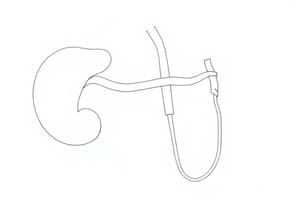Podcast
Questions and Answers
What is the primary action of secretin in the small intestine?
What is the primary action of secretin in the small intestine?
- Inhibits bile production
- Reduces the amount of H+ in the lumen (correct)
- Stimulates insulin release
- Stimulates gastric acid secretion
GIP contains 27 amino acids.
GIP contains 27 amino acids.
False (B)
Which cells release secretin in the duodenum?
Which cells release secretin in the duodenum?
S cells
Secretin is homologous to __________, sharing 14 of the same amino acids.
Secretin is homologous to __________, sharing 14 of the same amino acids.
Match the following peptides with their functions:
Match the following peptides with their functions:
What stimulates the release of secretin in the duodenum?
What stimulates the release of secretin in the duodenum?
What stimuli lead to the release of GIP?
What stimuli lead to the release of GIP?
Ghrelin is a hormone that decreases appetite.
Ghrelin is a hormone that decreases appetite.
Which GI hormone is involved in increasing insulin secretion?
Which GI hormone is involved in increasing insulin secretion?
____ is secreted primarily by cells in the duodenum and jejunum.
____ is secreted primarily by cells in the duodenum and jejunum.
Match the following hormones with their primary functions:
Match the following hormones with their primary functions:
Which hormone could be beneficial in the treatment of type 2 diabetes mellitus?
Which hormone could be beneficial in the treatment of type 2 diabetes mellitus?
Flashcards are hidden until you start studying
Study Notes
Secretin
- Composed of 27 amino acids, 14 of which are identical to glucagon.
- Essential for biological activity; all amino acids are necessary.
Actions of Secretin
- Reduces H+ ion concentration in the small intestine.
- Stimulates the pancreas to secrete bicarbonate (HCO3-), promoting exocrine pancreatic growth.
- Neutralizes H+ in the intestinal lumen through pancreatic bicarbonate.
- Encourages liver secretion of bicarbonate and water, enhancing bile production.
- Inhibits gastric parietal cells from secreting H+.
Stimuli for the Release of Secretin
- Released by S cells in the duodenum in response to:
- High H+ levels in the duodenal lumen.
- Presence of fatty acids in the duodenal lumen.
GIP (Glucose-dependent Insulinotropic Peptide)
- Contains 42 amino acids and shares homology with secretin and glucagon.
Actions of GIP
- Acts synergistically with other hormones to enhance insulin response.
- Integral in the regulation of glucose metabolism.
Stimuli for the Release of GIP
- Secreted by the duodenum and jejunum.
- Unique among GI hormones for responding to fat, protein, and carbohydrates.
- Release stimulated by:
- Fatty acids
- Amino acids
- Orally ingested glucose
Candidate Hormones in Gastrointestinal Physiology
- Secreted by gastrointestinal tract cells.
- Motilin: Increases GI motility and aids in interdigestive myoelectric complexes.
- Pancreatic Polypeptide: Inhibits pancreatic secretions.
- Glucagon-like Peptide-1 (GLP-1): Stimulates insulin secretion from pancreatic β cells; analogues may assist in treating type 2 diabetes.
- Leptin: Reduces appetite.
- Ghrelin: Stimulates appetite.
Studying That Suits You
Use AI to generate personalized quizzes and flashcards to suit your learning preferences.




